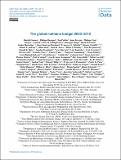The global methane budget 2000–2012
Author(s)
Prinn, Ronald G
DownloadSaunois-2016-The global methane budget 2000-20.pdf (3.668Mb)
PUBLISHER_CC
Publisher with Creative Commons License
Creative Commons Attribution
Terms of use
Metadata
Show full item recordAbstract
The global methane (CH[subscript 4]) budget is becoming an increasingly important component for managing realistic pathways to mitigate climate change. This relevance, due to a shorter atmospheric lifetime and a stronger warming potential than carbon dioxide, is challenged by the still unexplained changes of atmospheric CH[subscript 4] over the past decade. Emissions and concentrations of CH[subscript 4] are continuing to increase, making CH[subscript 4] the second most important human-induced greenhouse gas after carbon dioxide. Two major difficulties in reducing uncertainties come from the large variety of diffusive CH[subscript 4] sources that overlap geographically, and from the destruction of CH[subscript 4] by the very short-lived hydroxyl radical (OH). To address these difficulties, we have established a consortium of multi-disciplinary scientists under the umbrella of the Global Carbon Project to synthesize and stimulate research on the methane cycle, and producing regular (∼ biennial) updates of the global methane budget. This consortium includes atmospheric physicists and chemists, biogeochemists of surface and marine emissions, and socio-economists who study anthropogenic emissions. Following Kirschke et al. (2013), we propose here the first version of a living review paper that integrates results of top-down studies (exploiting atmospheric observations within an atmospheric inverse-modelling framework) and bottom-up models, inventories and data-driven approaches (including process-based models for estimating land surface emissions and atmospheric chemistry, and inventories for anthropogenic emissions, data-driven extrapolations). For the 2003–2012 decade, global methane emissions are estimated by top-down inversions at 558 Tg CH[subscript 4] yr[superscript −1], range 540–568. About 60 % of global emissions are anthropogenic (range 50–65 %). Since 2010, the bottom-up global emission inventories have been closer to methane emissions in the most carbon-intensive Representative Concentrations Pathway (RCP8.5) and higher than all other RCP scenarios. Bottom-up approaches suggest larger global emissions (736 Tg CH[subscript 4] yr[superscript −1], range 596–884) mostly because of larger natural emissions from individual sources such as inland waters, natural wetlands and geological sources. Considering the atmospheric constraints on the top-down budget, it is likely that some of the individual emissions reported by the bottom-up approaches are overestimated, leading to too large global emissions. Latitudinal data from top-down emissions indicate a predominance of tropical emissions (∼ 64 % of the global budget, < 30° N) as compared to mid (∼ 32 %, 30–60° N) and high northern latitudes (∼ 4 %, 60–90° N). Top-down inversions consistently infer lower emissions in China (∼ 58 Tg CH[subscript 4] yr[superscript −1], range 51–72, −14 %) and higher emissions in Africa (86 Tg CH[subscript 4] yr[superscript −1], range 73–108, +19 %) than bottom-up values used as prior estimates. Overall, uncertainties for anthropogenic emissions appear smaller than those from natural sources, and the uncertainties on source categories appear larger for top-down inversions than for bottom-up inventories and models.
The most important source of uncertainty on the methane budget is attributable to emissions from wetland and other inland waters. We show that the wetland extent could contribute 30–40 % on the estimated range for wetland emissions. Other priorities for improving the methane budget include the following: (i) the development of process-based models for inland-water emissions, (ii) the intensification of methane observations at local scale (flux measurements) to constrain bottom-up land surface models, and at regional scale (surface networks and satellites) to constrain top-down inversions, (iii) improvements in the estimation of atmospheric loss by OH, and (iv) improvements of the transport models integrated in top-down inversions. The data presented here can be downloaded from the Carbon Dioxide Information Analysis Center (http://doi.org/10.3334/CDIAC/GLOBAL_METHANE_BUDGET_2016_V1.1) and the Global Carbon Project.
Date issued
2016-12Department
Massachusetts Institute of Technology. Department of Earth, Atmospheric, and Planetary SciencesJournal
Earth System Science Data
Publisher
Copernicus GmbH
Citation
Saunois, Marielle et al. “The Global Methane Budget 2000–2012.” Earth System Science Data 8.2 (2016): 697–751.
Version: Final published version
ISSN
1866-3516